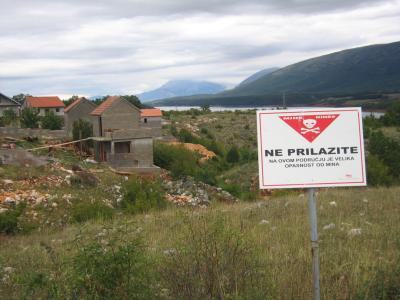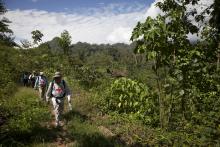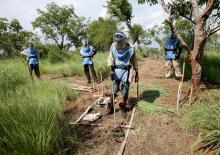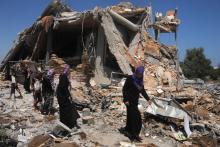Basic international humanitarian law (IHL) rules applicable to this situation:
The use of means and methods of warfare which cause superfluous injury or unnecessary suffering is prohibited.
When landmines are used, particular care must be taken to minimize their indiscriminate effects.
A party to the conflict using landmines must record their placement, as far as possible.
At the end of active hostilities, a party to the conflict which has used landmines must remove or otherwise render them harmless to civilians, or facilitate their removal.
The case in brief
A 1991–1995 armed conflict in the former Yugoslavia left parts of Croatia contaminated by landmines and explosive remnants of war (ERW). The associated danger prevents people from accessing the affected land and using it for agricultural and forestry-related activities, thereby limiting livelihood opportunities.
Croatia ratified the 1997 Convention on the Prohibition of the Use, Stockpiling, Production and Transfer of Anti-Personnel Mines and on their Destruction (Ottawa Convention) in 1998. It subsequently established the Croatian Mine Action Centre (CROMAC) and the Office for Mine Action (OMA) to handle the operational and political aspects of national mine action respectively. Looking to meet Croatia’s international obligations to clear all mine-affected land by 2026, CROMAC and OMA have proceeded with demining and awareness-raising activities across the country, clearing thousands of mines and ERW. The anticipated socio-economic benefits of clearance, political pressure, and funding support from a range of actors, including other states, have influenced these acts of compliance with IHL.
IHL compliance highlights
- In 2017, CROMAC supervised the clearance of nearly 30km2 of territory, destroying 1,271 anti-personnel mines, 18 anti-vehicle mines and 519 items of unexploded ordnance. The Croatian Police also collected and destroyed mines and ERW in partnership with the United Nations Development Programme.
- In 2018, CROMAC:
- completed the clearance of landmines from Brod-Posavina county, with support from the World Bank and the European Agricultural Fund, among others
- succeeded in defusing 9,567 ERW, including 3,585 ERW cleared in a record 39 days in a Swiss-funded operation.
- To minimize mine-related injuries, the Croatian authorities worked to increase public awareness of the dangers, erecting more than 12,000 warning signs and creating an app to alert the user when approaching a mined area.
Case prepared by Abdul Aziz, Ana Paula Vargas Rodrigues, Bethania Godinho, Mozna Abumery, and Sarawut Theerakul, International Humanitarian Action (NOHA) and European Human Rights and Democratisation (E.MA) Master students at the Bochum IHL Clinic, at the Institute for International Law of Peace and Armed Conflict (IFHV), Ruhr-Universität Bochum, under the supervision of Prof. Robert Heinsch and Prof. Valentina Azarova.
A. MINE CLEARANCE IN CROATIA
[Source: International Campaign to Ban Landmines: Landmine and Cluster Munition Monitor, ‘Croatia’, 5 November 2018, available at http://www.the-monitor.org/en-gb/reports/2018/croatia/mine-action.aspx, footnotes omitted]
Contamination
The Republic of Croatia is affected by mines and, to a much lesser extent, ERW [Explosive Remnants of War], including cluster munition remnants, a legacy of four years of armed conflict associated with the break-up of the former Yugoslavia in the early 1990s.
Mine contamination
At the end of 2017, Croatia had a total of 411km2 of mined area (0.73% of the entire land mass of Croatia), excluding military areas. Of this total, 269km2 across 57 sites was CHA [Confirmed Hazardous Areas], while mines were suspected to cover a further 142km2, across 47 SHAs [Suspected Hazardous Areas]. […]
[...]
Clearance in the county of Brod-Posavina was completed at the end of 2017. Sisak-Moslavina and Lika-Senj counties are the most heavily contaminated with antipersonnel mines, containing an estimated 12,741 and 11,390 antipersonnel mines, respectively, and accounting for 73.5% of the total number of antipersonnel mines emplaced.
[...]
The impact of mines in Croatia is predominantly socio-economic and at local level, preventing safe use of land for livestock and forestry-related activities. At the end of 2017, 89% of mine contamination was on forested land; 10% on agricultural land; and 1% on other areas (e.g. water, marshland, and coastal areas). […]
[...]
Program Management
CROMAC [Croatian Mine Action Centre] is responsible for the collection, processing, and recording of data on mine and ERW contamination, survey, and clearance; marking of contaminated areas; non-technical survey; quality control of clearance; technical survey, and the planning of demining and technical survey operations. CROMAC is accountable to the government of Croatia through the Managing Board (formerly known as the CROMAC Council) whose members are representatives of the relevant ministries and other stakeholders, appointed by the government
[...]
The Office for Mine Action (OMA) reports to the Prime Minister’s office, to function as a focal point for mine action, strengthen coordination among stakeholders and funding agencies, and raise public awareness about mine and ERW hazards. The OMA does not sit above CROMAC; rather, it is the government institution dealing with the political aspects of mine action, whereas CROMAC deals with operations. The OMA includes a Unit for European Union (EU) Funds, tasked with promoting access to a range of EU funds to support the mine action sector.
Strategic planning
CROMAC has a National Mine Action Strategy 2009–2019, which includes the goal of all mine clearance by 2019. Croatia subsequently submitted a request to extend its Mine Ban Treaty Article 5 deadline from 1 March 2019 to 1 March 2026.
[...]
The request for extension of the deadline destruction under the Mine Ban Treaty “has also been verified by the Croatian Government, […] thus giving it much needed political weight.”
[…]
Land Release (mined area)
Commercial demining operators working under the direction of CROMAC cleared nearly 30km2 across 73 mined areas in 2017, with the destruction of 1,271 antipersonnel mines, 18 antivehicle mines, and 519 items of UXO (see table below).
Mine clearance in 2017
|
Operator |
County |
Areas cleared |
Area cleared (m²) |
|
Alfa |
Šibenik-Knin |
1 |
4,080 |
|
Karlovac |
1 |
3,583 |
|
|
Capsula Interna |
Zadar |
2 |
320,337 |
|
Šibenik-Knin |
1 |
180,526 |
|
|
Cor |
Posavina |
1 |
287,099 |
|
Šibenik-Knin |
1 |
198,988 |
|
|
Zadar |
1 |
268,844 |
|
|
Brod-Posavina |
1 |
168,693 |
|
|
Sisak-Moslavina |
1 |
761,149 |
|
|
Credo |
Sisak-Moslavina |
1 |
7,610 |
|
Diz-Eko |
Sisak-Moslavina |
2 |
989,555 |
|
Šibenik-Knin |
2 |
718,263 |
|
|
Požega-Slavonia |
2 |
896,934 |
|
|
Sisak-Moslavina |
3 |
831,501 |
|
|
Zadar |
1 |
994,398 |
|
|
Lika-Senj |
1 |
642,427 |
|
|
Požega-Slavonia |
1 |
167,127 |
|
|
Fas |
Split-Dalmatia |
1 |
68,348 |
|
Lika-Senj |
1 |
2,092,518 |
|
|
Harpija |
Zadar |
3 |
243,046 |
|
Sisak-Moslavina |
1 |
109,945 |
|
|
Istraživač |
Zadar |
2 |
1,471,319 |
|
Sisak-Moslavina |
2 |
817,116 |
|
|
Osijek-Baranja |
2 |
1,876,734 |
|
|
Požega-Slavonia |
1 |
268,443 |
|
|
Istraživač Benz |
Sisak-Moslavina |
1 |
70,242 |
|
Maper |
Šibenik-Knin |
2 |
211,396 |
|
Mina Plus |
Zadar |
1 |
715,125 |
|
Mka Deming |
Sisak-Moslavina |
1 |
38,020 |
|
Mungos |
Brod-Posavina |
1 |
1,174,047 |
|
Požega-Slavonia |
1 |
407,594 |
|
|
Piper |
Osijek-Baranja |
1 |
511,492 |
|
Zadar |
1 |
354,830 |
|
|
Požega-Slavonia |
2 |
761,607 |
|
|
Šibenik-Knin |
1 |
214,037 |
|
|
Sisak-Moslavina |
1 |
455,717 |
|
|
Piton |
Požega-Slavonia |
1 |
209,110 |
|
Split-Dalmatia |
1 |
1,016,836 |
|
|
Šibenik-Knin |
1 |
183,448 |
|
|
Rumital |
Šibenik-Knin |
2 |
362,024 |
|
Lika-Senj |
2 |
1,547,461 |
|
|
Sisak-Moslavina |
1 |
2,086,603 |
|
|
Titan |
Osijek-Baranja |
1 |
355,643 |
|
Brod-Posavina |
1 |
516,211 |
|
|
Šibenik-Knin |
1 |
604,288 |
|
|
Split-Dalmatia |
1 |
755,389 |
|
|
Lika-Senj |
1 |
29,358 |
|
|
Tnt-7 |
Brod-Posavina |
1 |
62,693 |
|
Tornado |
Zadar |
1 |
86,438 |
|
Zeleni Kvadrat |
Požega-Slavonia |
2 |
355,855 |
|
Šibenik-Knin |
2 |
352,852 |
|
|
Zadar |
2 |
847,181 |
|
|
Brod-Posavina |
1 |
67,923 |
|
|
Karlovac |
1 |
1,010,570 |
|
|
Lika-Senj |
1 |
132,494 |
|
|
Total |
73 |
29,885,067 |
[...]
Also, as part of the continued “less arms, fewer tragedies” program, the Croatian Police (under the Ministry of Interior), and in partnership with the United Nations Development Programme (UNDP), collected 122 antipersonnel mines and 22 antivehicle mines, in addition to explosives, hand grenades, and other weapons and explosive ordnance, which were subsequently transported to and destroyed at Croatian military facilities.
[...]
B. BROD-POSAVINA COUNTY DECLARED FREE OF LANDMINES
[Source: N1 News, Brod-Posavina County declared free of landmines, 11 June 2018, available at https://n1info.hr/english/news/a309205-brod-posavina-county-declared-free-of-landmines/]
Brod-Posavina County was declared free of landmines on Monday at a ceremony at which Croatian Mine Action Centre (HCR) head Zdravko Modrusan presented prefect Danijel Marusic with a certificate to that effect.
After the 1991-95 war, Brod-Posavina was among Croatia's 14 counties contaminated with unexploded ordnance. Some 203 million kuna (€27.5 million) was invested from the national budget, public companies, the World Bank and the European Agricultural Fund to clear 100.3 square kilometres of land in the county.
“Almost 1,700 pieces of explosive devices leftover from the war were found and destroyed,” Interior Minister Davor Bozinovic said at the ceremony. He added that the last reported land mine related casualty was in 2016.
“There were no land mine-related accidents since then, and I think that is the biggest success of mine countermeasures system,” he said.
The deadline for the plan to clear the remaining counties was pushed back for another seven years, HCR head Modrusan said.
C. SWITZERLAND SUPPORTS DEMINING EFFORTS IN CROATIA
[Source: Swiss Federal Department of Foreign Affairs, In Croatia's woods 3,585 mines have been defused, 20 December 2018, available at https://www.eda.admin.ch/schweizerbeitrag/en/home/the-swiss-contribution/countries/kroatien.html/schweizerbeitrag/en/meta/news/2018/12/20/erfolgreiche-entminung-in-kroatien]
Mines and other explosive remnants of war are a dangerous legacy from Croatia's 1991–96 war and compromise the safety of the local people. Integrating mine victims economically and socially is a challenge for Croatian society. Switzerland's demining project under its enlargement contribution aims to improve life quality for people living in mined areas.
It is estimated that there are still several hundred square kilometres of heavily mined areas in Croatia. This is not just a threat to the local people but also prevents them from using their forests and farmlands. Croatia was supposed to have destroyed all anti-personnel mines on its territory by March 2019 in line with international agreements. This deadline has now been extended to 2026, because in spite of major national investment and financial support from the EU, demining is only advancing at a slow pace. The remaining areas are difficult to access and the demining work is costly and time-consuming. […]
Kotar-Stari Gaj woods cleared in record time
In September 2018, 294 local deminers defused 3,585 explosive remnants of the Croatian war covering 1.8 km² of the Kotar-Stari Gaj woods. The Swiss-funded operation was carried out in record time without interruption – only 39 days – thanks to thorough planning by the Croatian Mine Action Centre (CROMAC) and major human effort. [...] 2018 marked a record high for CROMAC with 9,567 defused explosive remnants of war. This area can only be definitively cleared as productive land when the surrounding areas have also been demined.
[...]
Awareness-raising helps reduce casualties
There has not been a mine-related incident in Croatia since 2017. One of the main reasons for this is raising public awareness of the risks involved. More than 12,300 mine warning signs have been put up throughout the whole of the country. CROMAC has also devised an app – Misportal – which provides detailed maps of dangerous areas to help people. App users get a warning if they start going towards a mined area. If they are in danger, they can press an alarm button which puts them through directly to the responsible service. […]
Economic and social integration for mine victims
In addition to physical demining and awareness-raising, victim support is an important pillar of the overall package of measures that fall under mine action. The Swiss-Croatian project includes the provision of support to victims and their families. A national database with an analysis of the needs of mine victims is under way, and measures to support the economic and social integration of affected people are being developed and should be implemented by the project's close in 2024.
[...]
Discussion
I. Classification of the Situation and Applicable Law
1. How would you classify the situation in Croatia between 1991 and 1995? Was there an armed conflict? If so, who were the parties to the conflict? What additional information would you require to make such a determination? (GC I-IV, Arts 2, 3; P I, Art. 1; PII, Art. 1)
2. What is the law applicable in relation to landmines? Are the rules on anti-personnel landmines applicable both to international and non-international armed conflicts? (PI, Art. 35; CCW, Art. 1; CCW Amended Protocol II, Art. 1; CCW Protocol V; Ottawa Convention, Art. 1; CIHL, Rules 70, 81, 82, 83)
II. Destruction of Stockpiles and Mine Clearance
3. Does a State have a duty to clear anti-personnel landmines when they are already scattered underground? On what information does the State have to base its clearance action? What is the time-frame of the mine clearance obligation? What other obligations do States have with respect to landmines? (CCW, Art. 1; CCW Amended Protocol II, Art.1(2), 10; Technical Annex to Amended Protocol II 1, 2; Ottawa Convention, Art. 5; CIHL, Rules 81, 82, 83)
4. What is the role of third States and international or regional organizations in the mine clearance process? Do third States have a duty to co-operate? (CCW Protocol II, Article 9)
5. Croatia has requested an extension in order to meet its obligations under the Mine Ban Treaty. Under which conditions, can a state submit such a request? What could “undue delay” mean? (Ottawa Convention, Art. 5)
III. Elements Contributing to Respect for IHL
6. (Documents A and C) Do you think that the fulfilment of Croatia’s IHL obligations towards demining could bring long-term benefits to the country? In your opinion, can a country social-economic development be a positive incentive to comply with IHL?
7. (Document C) How has the support of a broad range of actors, including other States, contributed to Croatia’s perseverance in pursuing its mine-removal efforts? Do you think international funding and investments played a critical role in the mine-clearance operations? What do you think motivates third states to support states in their demining efforts?
8. Document A states that the request for extension of the deadline destruction under the Mine Ban Treaty “has also been verified by the Croatian Government, […] thus giving it much needed political weight.” In your opinion, why is it important that the request for an extension carries the necessary political support at the governmental level? Do you think that a state’s difficulty in meeting the deadline under an international treaty puts political pressure on the government? Does it affect the state’s reputation at the international level?
9. (Document C) In your opinion, what is the significance of awareness raising initiatives as part of the mine-clearance process? What is the value of ‘Misportal’, the app developed by CROMAC? Do you think that innovation projects can have a positive effect on compliance with IHL?






